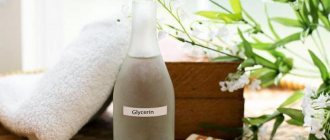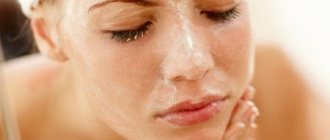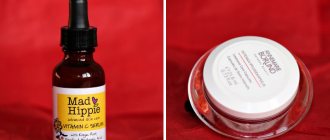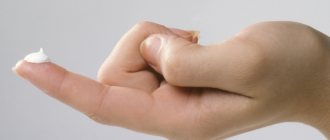How glycerin is obtained and its properties
Glycerin is the simplest trihydric alcohol obtained by the decomposition of fats. It is odorless and colorless, tastes sweet, and feels like thick syrup. Glycerin easily dissolves in alcohol and water and is insoluble in fatty and essential oils.
For cosmetic purposes, use diluted glycerin or in pure form. It is obtained from both natural and synthetic components; this does not affect the quality of the original product.
Glycerin is widely used in medicine and cosmetology due to its properties.
- Hydration. After application to the skin, it begins to absorb moisture and release it to the skin. Glycerin can be used for this purpose only when the air humidity is high, since in a dry climate it itself draws moisture from your skin.
- Protection. It forms an invisible thin film that effectively protects the skin from the negative effects of climate for a long time.
- Does not cause allergies. Glycerin can be used by people with sensitive skin, as it does not cause irritation, redness or rashes.
- Medicinal properties for eczema. Glycerin can increase the therapeutic effect of medications to prevent eczema and at the same time reduce their negative impact on the skin.
- Cleansing. Glycerin removes various impurities and dust from the skin well.
Danger of use
There is no data on the negative effects of glycerin and stearate on the human body. There is a possibility that the drug causes an allergic reaction in people with individual tolerance, but in principle it is considered absolutely safe and even beneficial for humans.
In addition, it is precisely because of its absence that negative reactions can occur.
Some experts believe that it is still not worth using it in the production of cosmetics. They claim that in fact it does not care for the skin and moisturize it, but draws out all the moisture and nutrients from it, and that with frequent use of products containing it, the skin will age too quickly and wrinkles will appear. But these are just words, there is no evidence.
When is glycerin harmful to the skin of your hands?
If glycerin is used incorrectly, it can harm the skin. Despite the fact that one of its main properties is moisturizing, glycerin can dry out the skin in the following conditions:
- the air is dry (its humidity is less than 65%). If there is little moisture in the air, glycerin, due to its hygroscopic properties, begins to absorb it from the skin, which leads to peeling and cracks. In winter, it is generally better to avoid using glycerin and creams based on it;
- it is used in pure form or as part of a cosmetic product containing glycerin more than 7%. To find out the amount of glycerin in a hand cream, you need to read the composition: the closer it is to the end of the list, the less its amount.
Glyceryl stearate derivatives
Glyceryl stearate derivative – Glyceryl Stearate SE. It is this component that is often used for the manufacture of cosmetics. Suitable as an emulsifier. The letters SE indicate that the compound can emulsify on its own. Used for cosmetics consisting of oil and water. Appearance Glyceryl Stearate SE – granules. It has the same properties as Glyceryl stearate, that is, it has a moisturizing and softening effect. This substance is not used in food.
Another derivative of Glyceryl stearate is Glyceryl Stearate Citrate. The substance is also used in cosmetics. Perhaps it is the word citrate that causes mistrust. But in reality, there is no reason to be afraid. Glyceryl Stearate Citrate is a compound that contains oils and citric acid. No toxicity has been detected in it, the component does not cause harm. The only thing that distinguishes Glyceryl Stearate Citrate from Glyceryl stearate is that the first component has a light, unobtrusive lemon aroma.
How to prepare masks and hand creams from glycerin
Glycerin is present in almost all hand care products, regardless of their price. At home, you can make effective glycerin-based masks and creams from inexpensive and readily available ingredients.
Hand masks
- A glycerin mask based on honey is suitable for nourishing and caring for your hands in winter. In a small bowl, mix one part each of honey, glycerin and starch, dilute with three parts water. Apply the mask for 15 minutes and rinse with plain water.
- A mask with olive oil has a rejuvenating and whitening effect. Take a teaspoon each of lemon juice and olive oil, glycerin and oatmeal flour. Add all ingredients in the following order: oatmeal, water, olive oil, lemon juice, glycerin. You should keep the mask on your hands for no more than 20 minutes.
- A mask of yolks and glycerin nourishes the skin and strengthens nails. Mix two yolks, a tablespoon of glycerin and 50 ml of almond or olive oil. The mask is applied to your hands in a thick layer; to enhance the effect, you should wrap your hands in cellophane and a warm towel for 20 minutes. The resulting amount of mask is enough for two uses, so the remaining mixture can be stored in the refrigerator.
Hand creams
- To prevent cracking and peeling of the skin of your hands, infuse chamomile flowers in hot water, a tablespoon per 100 ml of water. Heat 50 g of ghee in a water bath and, slowly stirring it with a spoon, add half a teaspoon of glycerin, 50 ml of chamomile infusion and 30 ml of camphor. Cooled cream should only be stored in the refrigerator for a maximum of two weeks.
- For daily care of hands and nails, mix a tablespoon of 9% vinegar and glycerin, add a teaspoon of base oil (almond, olive, grape seed). Rub this composition into the skin until completely absorbed before going to bed.
- You can achieve a whitening and toning effect using a cream based on lemon juice. It is necessary to squeeze out the juice of two lemons, and infuse their zest in 200 ml of hot water. Add to the resulting lemon juice a teaspoon of vitamin A in an oil solution, honey, glycerin and camphor alcohol, an yolk, 100 g of melted butter and an infusion of lemon zest.
All glycerin-based creams are stored only in the refrigerator, and masks are used immediately after preparation. Daily use of these glycerin-based home remedies makes your skin smooth, velvety and moisturized and your nails strong.
Author - Gordeychuk Vitaly
Using glycerin on hands
When looking for an inexpensive skin moisturizer, many people pay attention to glycerin-containing products or concentrated medical glycerin. Note that its use may be limited not only when creating home remedies, but also various ointments and creams.
Such high popularity is primarily due to the fact that the substance is cheap and can be of natural or synthetic origin. Glycerin for hands at home can also be used as a moisturizer. Let's consider the benefits of glycerin, its features, and how it is used.
Application in the creation of folk remedies
Glycerin can be very beneficial for the skin of your hands. This is due to the following points:
- When applied, the substance forms a continuous film that protects the skin surface from various types of influences;
- Glycerin holds back water, which prevents large amounts of it from leaving the cells.
When analyzing the question of how to find a use for glycerin for hands, we note that there are quite a lot of folk recipes that involve mixing several ingredients to increase the effective properties of each component. You can create masks, compresses, and various creams.
Recommended Recipes
By using glycerin for your hands at home, recipes for folk remedies will be discussed below, you can achieve good results in moisturizing the skin. It is worth considering that folk remedies can be used for a long period.
The most common recipes that involve partial or complete use of glycerin for hands at home are:
- Mask for dry and dehydrated skin with honey and milk;
- Alcohol mask;
- Potato mask;
- Fermented milk mask;
- A combination of glycerin and apple cider vinegar;
- Starch and glycerin.
Let us consider the features of preparing each product in more detail.
Mask for dry and dehydrated skin
There are many reasons why the skin becomes dehydrated. There are a large number of masks and ointments on sale that can help with this problem.
However, their cost can be high; many will contain glycerin as one of the main components. The main ingredients of this mask are:
- Glycerin 1 teaspoon;
- Natural honey 1 teaspoon;
- 1 teaspoon each of milk and water;
- Oatmeal 1 tablespoon.
All the ingredients in question should be mixed, the mask should be applied only after cleansing the skin. It is recommended to keep the mask on for 20 minutes. After this, the mask is washed off with plain water at room temperature. In this case, glycerin for hands at night can be used because all the ingredients soften the skin.
Watch the video about the recipe for a hand skin mask.
Alcohol combined with glycerin
In some cases, there is a need not only to moisten the surface, but also to disinfect it. The combination of glycerin and alcohol is quite popular. To dilute these components, regular bottled water is used. All components are taken 1 to 1, mixed thoroughly and the resulting result is used as a compressor.
Read about getting rid of age spots on the face and hands. And also about hand masks at home.
An important point is that alcohol and glycerin are harmful to hands if exposed to sensitive areas of the skin for a long time. Therefore, the compressor should not be kept on for long.
Potato and glycerin mask
Over the years, potatoes have also been used to create various folk remedies to moisturize the skin. Recommendations for preparing a potato mask with the addition of glycerin are as follows:
- Take one potato and boil it in its jacket;
- Some time is given for the potatoes to cool, after which they need to be peeled and mashed. The result should be a puree-like mass;
- For one medium-sized potato, you can use one teaspoon of glycerin;
- The resulting mixture should be mixed thoroughly.
Glycerin fermented milk mask
There is also a mask that is created by mixing fermented milk products and glycerin. The components are as follows:
- Sour cream, kefir or fermented baked milk;
- Glycerol;
- Honey.
The fermented milk product is taken in the amount of 1-2 tablespoons, glycerin in the amount of 0.5 teaspoon. If honey is added, then it is taken in the amount of 1 teaspoon. All components are thoroughly mixed and applied to hands, the composition is washed off after 20-30 minutes.
Uses of glycerin and apple cider vinegar
Some folk remedies allow the use of apple cider vinegar as one of the main components. In this case, 2 tablespoons of glycerin and 1 tablespoon of natural apple cider vinegar are mixed. The resulting mixture is suitable for lubricating your hands at night. You can also put on cotton gloves for 30-40 minutes
In conclusion, we note that using glycerin for hands has many advantages. An example is the low cost of all components, preparation of the mask within a short period of time, and the fairly high effectiveness of the product. However, it is worth considering the fact that only with long-term use of some folk remedies can the desired effect be achieved.
The benefits and harms of using products with glycerin
Speaking of benefits, I would like to note that glycerin is used in most cases to moisturize the skin. The product covers the skin with a thin film and does not allow moisture to evaporate. After using glycerin, your hands immediately become soft and very pleasant to the touch. It should also be noted that the component helps improve skin color, making the overall tone of the dermis softer and smoother.
This alcohol, used in small quantities, is able to retain moisture, thereby preventing the appearance of wrinkles and age-related changes in the skin. The component is also capable of peeling, removing dead skin on the hands, thereby making it softer and more velvety.
There are also negative opinions regarding the use of glycerin and products containing it as cosmetic products. The fact is that the described component can greatly dry out the skin - this happens in situations where the humidity of the air or environment is higher than the humidity of the skin. Under such conditions, glycerin sucks out all the moisture from the deep layers of the dermis. Also, high levels of this component in skin care products poison the body, which can lead to extremely negative consequences.
What is glycerin
Glycerin is a colorless, viscous liquid with a sweetish taste, which is obtained by chemical synthesis based on vegetable oils or animal fats. From a chemical point of view, glycerin is a polyhydric alcohol, its formula is HOCH2-CH(OH)-CH2OH.
Vegetable glycerin is usually made from coconut or palm oils. This is what is used to add to creams, soaps and shower gels.
In the food industry, pure glycerin is used as an emulsifier and flavor stabilizer, its designation is E422, and is considered safe and hypoallergenic.
The chemical structure of glycerin ensures its increased penetration into human skin, which determines the main cosmetic property of this ingredient - to deeply moisturize the skin and prevent further moisture loss.
So what, then, is the harm of such seemingly beneficial glycerin, which is also extracted from natural “sources”?
Receipt
Glycerin is obtained from various sources:
- Vegetable - from coconut and palm oils.
- Animal - from animal fat, most often pork.
- Chemical - synthesized from propylene.
Nowadays, animal glycerin is practically not used in cosmetics. Vegetable glycerin is most often used instead, as consumers have begun to look at cosmetic ingredients and worry about the environment. However, be careful if you are a supporter of eco-cosmetics. It is better to once again clarify the source of origin of this ingredient.
Beneficial features
- Hygroscopicity. Molecules of the substance absorb and accumulate moisture. Due to their small size, they penetrate deep into the skin and help saturate all its layers with water;
- An important component of the epidermis. It is unlikely that opponents of glycerin know that the substance is produced by the cells of the human body. Glycerol is an active participant in the internal water circulation system in cell membranes. If for some reason the body’s production of a substance has decreased, then a cosmetic product containing it will help replenish the missing moisture;
- Protective function. Due to its ability to fill small wrinkles and microcracks with moisture, the substance prevents dust particles and microorganisms from entering the upper skin layers, thereby protecting the epidermis from inflammation and irritation. Also, glycerin-containing products are endowed with the ability to protect the skin from penetration of irritating substances (for example, sodium lauryl sulfate).










